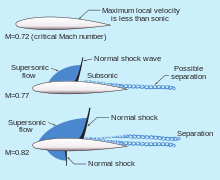Transsonische Strömung

Bei einer transsonischen Strömung treten im Strömungsfeld eines kompressiblen Fluids gleichzeitig Bereiche mit Strömungsgeschwindigkeiten im Unter- und Überschallbereich auf.
Bei einem Flugzeug, das noch mit weniger als Schallgeschwindigkeit fliegt, kann in der Umströmung lokal, das heißt örtlich, die Schallgeschwindigkeit überschritten werden. Der Übergang von Überschall- zur Unterschallströmung im Strömungsweg der Luft ist mit einem Verdichtungsstoß verbunden, der einen hohen Strömungswiderstand bewirkt und Einfluss auf die Druckverteilung am Flugzeug hat. Lange Zeit war daher das Überschreiten der Schallgeschwindigkeit mit Flugzeugen eine ungelöste Herausforderung, wofür der Begriff Schallmauer geprägt wurde.
Bei Flugzeugen liegt der transsonische Bereich etwa bei Machzahlen von Ma = 0,8 bis 1,2. Die Fluggeschwindigkeit, ab der ein transsonischer Strömungzustand auftritt, das heißt die Untergrenze des transsonische Bereiches, wird durch die kritische Machzahl Makrit bezeichnet.
Siehe auch
Weblinks
Auf dieser Seite verwendete Medien
High speed airplanes designed for subsonic flight are limited to some Mach number below the speed of sound to avoid the formation of shock waves that begin to develop as the airplane nears Mach 1.0. These shock waves (and the adverse effects associated with them) can occur when the airplane speed is substantially below Mach 1.0. The Mach speed at which some portion of the airflow over the wing first equals Mach 1.0 is termed the critical Mach number (MACHCRIT).. This is also the speed at which a shock wave first appears on the airplane. There is no particular problem associated with the acceleration of the airflow up to the point where Mach 1.0 is encountered; however, a shock wave is formed at the point where the airflow suddenly returns to subsonic flow. This shock wave becomes more severe and moves aft on the wing as speed of the wing is increased, and eventually flow separation occurs behind the well-developed shock wave. [Figure 15-9]
